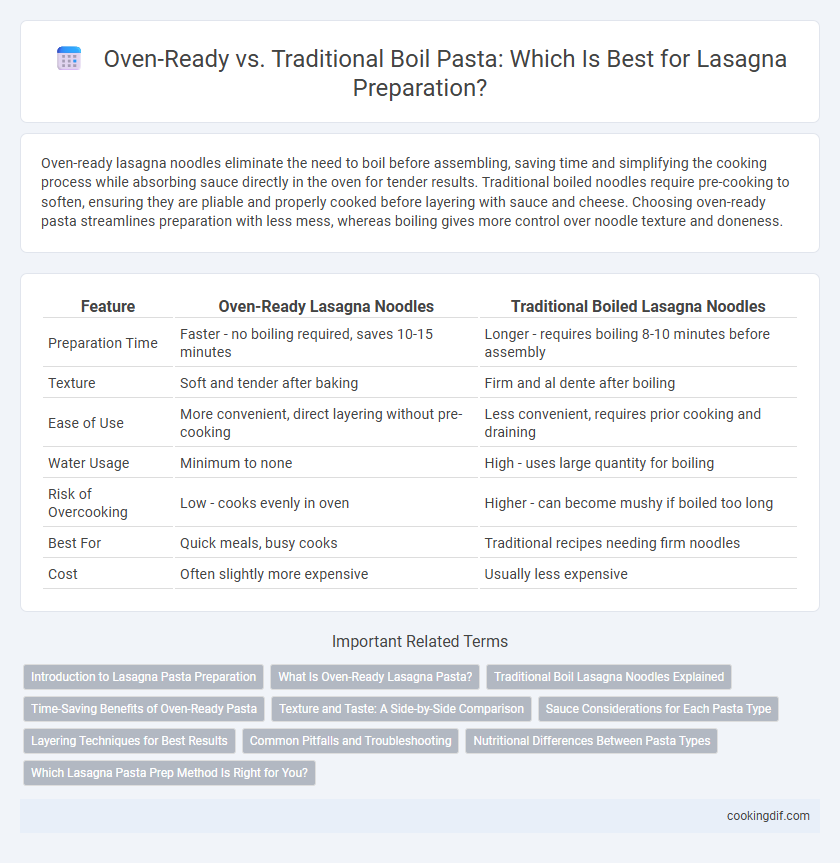Oven-ready lasagna noodles eliminate the need to boil before assembling, saving time and simplifying the cooking process while absorbing sauce directly in the oven for tender results. Traditional boiled noodles require pre-cooking to soften, ensuring they are pliable and properly cooked before layering with sauce and cheese. Choosing oven-ready pasta streamlines preparation with less mess, whereas boiling gives more control over noodle texture and doneness.
Table of Comparison
| Feature | Oven-Ready Lasagna Noodles | Traditional Boiled Lasagna Noodles |
|---|---|---|
| Preparation Time | Faster - no boiling required, saves 10-15 minutes | Longer - requires boiling 8-10 minutes before assembly |
| Texture | Soft and tender after baking | Firm and al dente after boiling |
| Ease of Use | More convenient, direct layering without pre-cooking | Less convenient, requires prior cooking and draining |
| Water Usage | Minimum to none | High - uses large quantity for boiling |
| Risk of Overcooking | Low - cooks evenly in oven | Higher - can become mushy if boiled too long |
| Best For | Quick meals, busy cooks | Traditional recipes needing firm noodles |
| Cost | Often slightly more expensive | Usually less expensive |
Introduction to Lasagna Pasta Preparation
Oven-ready lasagna noodles offer convenience by eliminating the boiling step, absorbing sauce moisture directly during baking for a quicker preparation process. Traditional pasta requires pre-boiling to achieve the ideal texture and prevent a chewy final dish, ensuring even layering and thorough cooking. Selecting between these types depends on desired texture, cooking time, and moisture content in the sauce for optimal lasagna results.
What Is Oven-Ready Lasagna Pasta?
Oven-ready lasagna pasta consists of thin, pre-cooked sheets designed to eliminate the boiling step, allowing direct layering and baking in the oven. This type of pasta absorbs moisture from sauces during baking, simplifying preparation and reducing overall cooking time. Traditional boiled pasta requires pre-cooking to achieve the desired texture before assembling the lasagna, which adds extra preparation and handling.
Traditional Boil Lasagna Noodles Explained
Traditional boil lasagna noodles require immersing pasta sheets in boiling salted water for 8 to 12 minutes until al dente, ensuring optimal texture and starch release for better sauce absorption. This method prevents undercooked layers and promotes even baking by softening the noodles thoroughly before assembling the dish. Using traditional boiled noodles enhances the classic lasagna's richness and structural integrity compared to oven-ready alternatives.
Time-Saving Benefits of Oven-Ready Pasta
Oven-ready lasagna pasta sheets eliminate the need for boiling, significantly reducing meal preparation time by allowing direct layering and baking. These sheets absorb sauce and cook evenly in the oven, streamlining the cooking process without compromising texture or flavor. Using oven-ready pasta enhances convenience, making it ideal for quick, delicious lasagna dishes.
Texture and Taste: A Side-by-Side Comparison
Oven-ready lasagna sheets offer a smoother texture and subtly blend flavors as they absorb moisture from sauces during baking, resulting in a tender yet firm bite. Traditional boiled pasta provides a more al dente texture with pronounced wheat flavor, maintaining a slightly chewier consistency that contrasts with the layered sauce and cheese. The choice between oven-ready and boiled pasta affects the overall mouthfeel and taste balance in lasagna, with oven-ready favoring convenience and softness and boiled pasta enhancing robustness and bite.
Sauce Considerations for Each Pasta Type
Oven-ready lasagna noodles absorb sauce differently compared to traditional boiled pasta, requiring a wetter sauce to ensure proper hydration and prevent dryness during baking. Traditional boiled noodles, already softened, benefit from thicker, less watery sauces that cling well and avoid sogginess. Adjusting sauce consistency based on pasta type is essential for achieving the ideal texture and flavor balance in lasagna dishes.
Layering Techniques for Best Results
Oven-ready lasagna noodles eliminate the boiling step, allowing for quicker layering and less mess, but require sufficient sauce moisture to soften properly during baking. Traditional boiled noodles offer a flexible texture that prevents dryness and improves seamless layering, especially when alternating with ricotta or bechamel. For optimal results, ensure even sauce distribution and minimal noodle overlap to create uniform layers that bake evenly and absorb flavors thoroughly.
Common Pitfalls and Troubleshooting
Oven-ready lasagna noodles save time but often result in uneven texture if insufficient sauce is used, as they rely on moisture absorption during baking. Traditional boiled noodles provide more control over texture but risk overcooking or sticking together if not properly drained and separated. Avoid common pitfalls by ensuring adequate sauce coverage for oven-ready noodles and rinsing boiled noodles to remove excess starch, preventing clumping in the layers.
Nutritional Differences Between Pasta Types
Oven-ready lasagna noodles often contain added emulsifiers and preservatives, which can slightly alter their nutritional profile by increasing sodium content compared to traditional boil pasta. Traditional boiled pasta tends to retain more natural nutrients, including higher fiber and protein levels, due to minimal processing. Choosing whole grain versions of either type enhances fiber content and provides a lower glycemic index, benefiting blood sugar control and digestive health.
Which Lasagna Pasta Prep Method Is Right for You?
Oven-ready lasagna sheets save time by eliminating the boiling step, absorbing sauce during baking for a softer texture, making them ideal for busy cooks. Traditional boiled pasta offers a firmer bite and better layer separation, preferred by those who prioritize texture and a more classic lasagna experience. Choosing between oven-ready and boiled noodles depends on your desired convenience versus texture balance in the final dish.
Oven-ready vs Traditional boil for pasta prep Infographic

 cookingdif.com
cookingdif.com